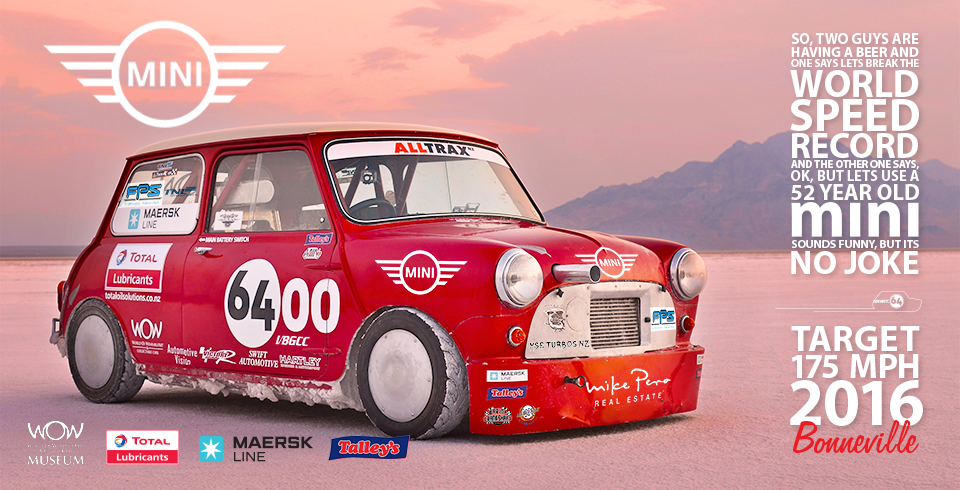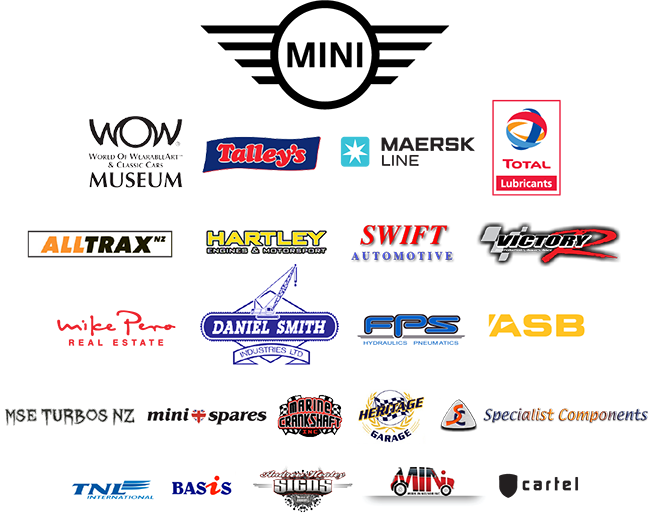It took two years of preparation, and 8000 miles to get us to Bonneville Speed Week, a legendary, crazy week in the middle of an ancient lake in the centre of a vast and crazy continent. The sun’s hot rays beat down relentlessly and reflected up at us off the Salt but the pressure to succeed made the sun seem minor.
We were here to attempt to break a sub 1000cc land speed record with a 1964 Mk1 Mini Cooper 970s powered by a Frankensteinian motor – mostly A-series, part BMW, part blood, sweat and tears. That meant exceeding 131 mph (210 kph) in a 48 year old Mini.
We had a bunch of supporters. Most of them believed we would do it, the rest wanted to believe but doubted it was possible. The Cooper was beautifully presented but completely untested and here we were, standing on legendary, tarmac-smooth salt plains that stretched to distant blue hills. The following ten days or so would be filled with highs and lows, smiles and tears. We would learn a huge amount about our wee Mini and ourselves.
Bonneville presents a lot of challenges, just figuring how everything happens can be a bit confusing, but there is plenty of advice on tap. The altitude is 1286m which is complicating for a car tuned at sea level, plus as the day heats up the air gets less dense, as if the altitude was increasing (2100m was the highest we measured). Having a turbo-charged car, as we did, helps. The salt surface itself isn’t like anything else you’ve ever driven on. A good driver helps here – we had that in young Nelson Hartley. The distances are big. If you’re kiwis, you’re almost 13000km from home, and its 10km from the pits to the start line, and depending on where you are in the queue for the start it can be 500m to a loo. Thinking ahead helps with all of these. Of course, the hardest bit is you chose a car designed to be an economical runabout, that goes around corners quickly but never went that well in a straight line, for your record attempt. Having a lot of power, oodles of motorsport experience and a beautifully prepared car helps there.
The car did have a lot of power – about 280 hp on petrol. More importantly it was pulling 9000rpm on the dyno before we came over, good for 150 mph (241 kph – its the USA so everything is done old school). We were running a 970S Cooper motor – chosen for its big bore and short stroke (which reduces the load on the centre main bearing) mated to a BMW K1200 4 valve per cylinder head (lots of breathability and no pushrods), fuel injection, intercooled IHI turbo, especially machined cams… It was a pretty special engine, based on Specialist Components’ kit but then developed further to suit our needs.
The other factor is aerodynamics. Minis have a reputation for being ‘flying bricks’ and having poor aerodynamics. What everyone forgets is that they have a tiny frontal area – one of the biggest factors in calculating the drag coefficient of a vehicle. Add to that the lower density air at altitude and you’re going quicker than you might think.
The record class we ran in was I/BGCC – I for engine size between 750 and 1000cc, B for blown – turbo or supercharged, G for gas (petrol), CC for competition coupe, which restricted body mods to an airdam and a smooth underbelly panel. The car we were aiming to take the record from was 26 years younger.
Our first two runs were 113 and 126 mph (181 and 203 kph) – the plan was to settle in and let Nelson get a feel for the car. No one was betting we’d have the motor out on the first day of racing. It was looking promising but the main bearings had failed. The engine came out, the spare was put in and we were racing again by 3:30 the next day. Nelson took the Cooper to 138.7mph at the 2 1/4 mile point, a speed that showed we could beat the 131 mph record, but the motor was out again by 6:30. This time it was clear that changes were necessary. It was the same problem as before but worse: bearings and crankshaft. Perhaps the nay-sayers were right – maybe the A-series just wasn’t able to handle that sort of power?
If anyone was thinking that they kept it to themselves. The team’s core brains gathered around the mini engine hashing out what was causing the problem and designing a solution. Everyone here knew it was possible. It was a great thing to watch. From there a plan was hatched. New parts needed to be ordered in (no easy feat in the US late in the day) and the motor was bundled into an old Ford Bronco and headed to Salt Lake City. The problem was one that it turned out everyone struggles with at Bonneville. We weren’t getting enough oil back to the bearings because we were spending so much longer at maximum revs than a circuit car would. We needed a workshop to re-plumb and improve the flow of oil back from the head to the crankshaft bearings, so three of the team went to legendary engine builder Steve Jenning’s workshop in Tooele, just outside of Salt Lake City. When we visited Steve on the way to Bonneville he had offered his workshop should we need it and he gave us free reign.
For those of us back at Bonneville, it was a chance to have a look at the spectacle of Speed Week, clean the Mini, explore the Wendover Airfield (where the Enola Gay crew trained), catch up on some washing and sleep plus shift camp to a quieter spot than the truck stop we had ended up in.
The new, improved motor was in the car by 9:30am on Wednesday – the third to last day of racing. We were racing again just after lunch and in the impound 20 minutes later – thats a good thing. Nelson had eased the car up to an average of 142.103 mph (229 kph) on mile 2 of course 3. It seemed like our reliability worries had been solved and we had qualified for a record. Once you qualify for a record, you’ve got an hour to get to impound, then up to 4 hours to prepare the car for your record run at 7am the next day. You have to break the existing record twice on the same timed section of the same track. The average speed of those two runs is your record. We were half way there.
Its a pre-dawn start for record qualifiers, you’ve got about 45 minutes to prepare the car, a supervised tow to the start line, then you queue, you run, you collect your timing ticket, head to tech inspection and if you pass that, you have your record. Thats pretty much how it panned out – Nelson clocked 151.087 mph (243 kph) and after the engine’s capacity and fuel seals were checked the record was ours – 146.595 mph (236 kph). We were stoked, even more so because of the efforts of the past few days.
What do you do when you’ve just broken a record? Try again. We were at the start line again just after midday, and again in impound about half an hour later. 156.045mph averaged between mile two and three – thats 251 kph!
Sadly, it wasn’t until we saw the steam pumping out of the Minis exhaust in the cool pre-dawn air the next morning that we realised we had a blown head gasket. It was the last day of racing and we had about 30 minutes left to replace it before we were due at the start line, and 20 minutes of that would have been travelling to our pit to get parts. Our racing was over.
It was a sad way to end but we had the record and we had seen a potential well beyond that. We could leave with our heads held high and maybe start hatching plans to return…
Written by Mike Wilson and republished from The BMC Experience
Please support us by donating any amount you like, securely via PayPal:


